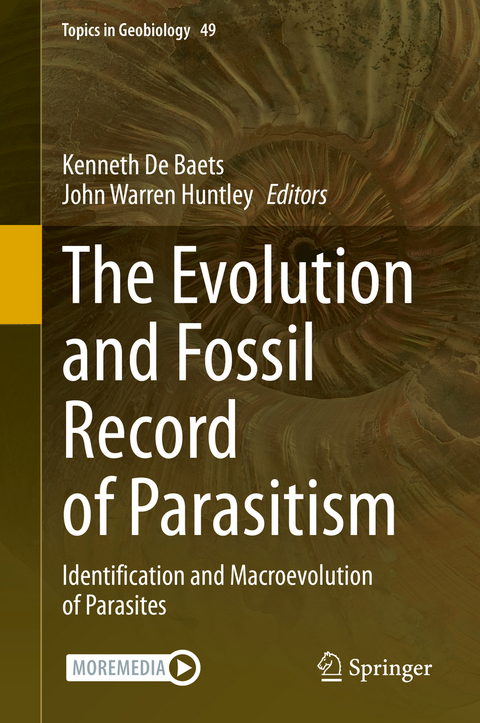
The Evolution and Fossil Record of Parasitism
Springer International Publishing (Verlag)
978-3-030-42483-1 (ISBN)
This two-volume edited book highlights and reviews the potential of the fossil record to calibrate the origin and evolution of parasitism, and the techniques to understand the development of parasite-host associations and their relationships with environmental and ecological changes. The book deploys a broad and comprehensive approach, aimed at understanding the origins and developments of various parasite groups, in order to provide a wider evolutionary picture of parasitism as part of biodiversity. This is in contrast to most contributions by parasitologists in the literature that focus on circular lines of evidence, such as extrapolating from current host associations or distributions, to estimate constraints on the timing of the origin and evolution of various parasite groups. This approach is narrow and fails to provide the wider evolutionary picture of parasitism on, and as part of, biodiversity.
Volume one focuses on identifying parasitism in the fossil record, and sheds light on the distribution and ecological importance of parasite-host interactions over time. In order to better understand the evolutionary history of parasites and their relationship with changes in the environment, emphasis is given to viruses, bacteria, protists and multicellular eukaryotes as parasites. Particular attention is given to fungi and metazoans such as bivalves, cnidarians, crustaceans, gastropods, helminths, insects, mites and ticks as parasites. Researchers, specifically evolutionary (paleo)biologists and parasitologists, interested in the evolutionary history of parasite-host interactions as well as students studying parasitism will find this book appealing.Dr. Kenneth De Baets is a Paleobiologist in the faculty of Natural Sciences at Friedrich-Alexander University Erlangen-Nurnberg. His main research interests include reproductive strategies and macroevolutionary patterns of biotic interactions (parasitism) and abiotic factors (climate), and spatial and temporal distributions of Paleozoic diversity and body size. Dr. John Huntley is an Assistant Professor in the Department of Geological Sciences at the University of Missouri. He graduated from Appalachian State University with a Bachelors of Science in 2000, then earned his Masters in Geology at the University of North Carolina at Wilmington in 2003, and his PhD in Geosciences at Virginia Polytechnic Institute and State University in 2007. His main research interests include the fossil record of biotic interactions, stratigraphic and conservation paleobiology, and the evolution of morphological disparity.
Chapter 1. Parasites of Fossil Vertebrates: What We Know and What can We Expect from the Fossil Record?.- Chapter 2. Fossil Record of Viruses, Parasitic Bacteria and Parasitic Protozoa.- Chapter 3. Fungi as Parasites: A Conspectus of the Fossil Record.- Chapter 4: Evolution, Origins and Diversification of Parasitic Cnidarians.- Chapter 5. Evolutionary History of Bivalves as Parasites.- Chapter 6. Gastropods as Parasites and Carnivorous Grazers - A Major Guild in Marine Ecosystems.- Chapter 7: Fossil Constraints on the Timescale of Parasitic Helminth Evolution.- Chapter8. Thorny-headed Worms (Acanthocephala): Jaw-less Members of Jaw-bearing Worms that Parasitize Jawed Arthropods and Jaw-bearing Vertebrates.- Chapter 9. Chelicerates as Parasites.- Chapter 10. Evolutionary History of Crustaceans as Parasites.- Chapter 11. The History of Insect Parasitism and the Mid-Mesozoic Parasitoid Revolution.
"The diagrams, drawings, and photographs throughout are well done and professional, and really helped to tell the story being presented by each author. ... the whole book was interesting to read. With all of that, The Evolution and Fossil Record of Parasitism is a great resource for anyone with a serious interest in the microworld of parasites and their role in the fossil record." (Lorin R. King, The Quarterly Review of Biology, Vol. 97 (2), June, 2022)
"The diagrams, drawings, and photographs throughout are well done and professional, and really helped to tell the story being presented by each author. … the whole book was interesting to read. With all of that, The Evolution and Fossil Record of Parasitism is a great resource for anyone with a serious interest in the microworld of parasites and their role in the fossil record.” (Lorin R. King, The Quarterly Review of Biology, Vol. 97 (2), June, 2022)
| Erscheinungsdatum | 09.05.2021 |
|---|---|
| Reihe/Serie | Topics in Geobiology |
| Zusatzinfo | XII, 565 p. 147 illus., 96 illus. in color. |
| Verlagsort | Cham |
| Sprache | englisch |
| Maße | 155 x 235 mm |
| Gewicht | 1087 g |
| Themenwelt | Naturwissenschaften ► Biologie ► Ökologie / Naturschutz |
| Naturwissenschaften ► Geowissenschaften ► Geologie | |
| Schlagworte | Bacteria as pathogens • Coprolites • Host responses • Identifying parasitism in the fossil record • Metazoa as parasites • Molecular perspectives • Paleoparasitology techniques • Parasite-induced traces and pathologies • Plants as parasites • Viral fossils |
| ISBN-10 | 3-030-42483-9 / 3030424839 |
| ISBN-13 | 978-3-030-42483-1 / 9783030424831 |
| Zustand | Neuware |
| Informationen gemäß Produktsicherheitsverordnung (GPSR) | |
| Haben Sie eine Frage zum Produkt? |
aus dem Bereich


